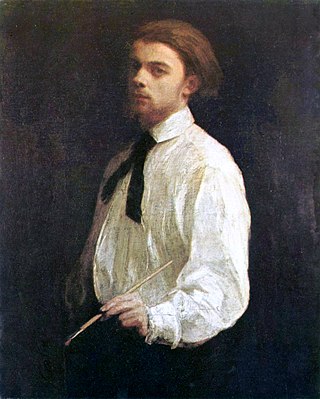
Henri Fantin-Latour was a French painter and lithographer best known for his flower paintings and group portraits of Parisian artists and writers.
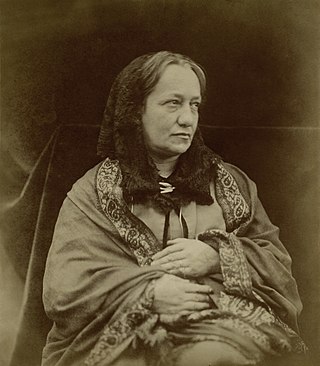
Julia Margaret Cameron was a British photographer who is considered one of the most important portraitists of the 19th century. She is known for her soft-focus close-ups of famous Victorians and for illustrative images depicting characters from mythology, Christianity, and literature.

Jan Davidsz. de Heem or in-full Jan Davidszoon de Heem, also called Johannes de Heem or Johannes van Antwerpen or Jan Davidsz de Hem, was a still life painter who was active in Utrecht and Antwerp. He is a major representative of that genre in both Dutch and Flemish Baroque painting.

Roger Fenton was a British photographer, noted as one of the first war photographers.
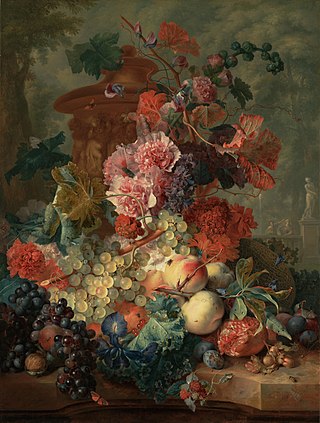
Jan van Huysum is the most notable member of the Van Huysum family of artists working in Dutch Golden Age of the 17th and 18th centuries; "by common consent, Jan van Huysum has been held to be the best painter of flowers." Trained in decoration from a young age, he "gradually developed an execution of details of the utmost beauty and finish" creating "wonderful flower pieces whereon drops of water and crawling ants could be seen without a magnifying glass."

Abraham Mignon or Minjon, was a still life painter. He is known for his flower pieces, still lifes with fruit, still lifes in forests or grottoes, still lifes of game and fish as well as his garland paintings. His works are influenced by those of Jan Davidszoon de Heem and Jacob Marrel.

War photography involves photographing armed conflict and its effects on people and places. Photographers who participate in this genre may find themselves placed in harm's way, and are sometimes killed trying to get their pictures out of the war arena.
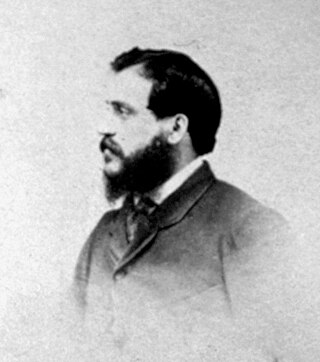
Felice Beato, also known as Felix Beato, was an Italian–British photographer. He was one of the first people to take photographs in East Asia and one of the first war photographers. He is noted for his genre works, portraits, and views and panoramas of the architecture and landscapes of Asia and the Mediterranean region. Beato's travels gave him the opportunity to create images of countries, people, and events that were unfamiliar and remote to most people in Europe and North America. His work provides images of such events as the Indian Rebellion of 1857 and the Second Opium War, and represents the first substantial body of photojournalism. He influenced other photographers, and his influence in Japan, where he taught and worked with numerous other photographers and artists, was particularly deep and lasting.

Abraham Brueghel was a Flemish painter from the famous Brueghel family of artists. He emigrated at a young age to Italy where he played an important role in the development of the style of decorative Baroque still lifes.

The term bodega in Spanish can mean "pantry", "tavern", or "wine cellar". The derivative term bodegón is an augmentative that refers to a large bodega, usually in a derogatory fashion. In Spanish art, a bodegón is a still life painting depicting pantry items, such as victuals, game, and drink, often arranged on a simple stone slab, and also a painting with one or more figures, but with significant still life elements, typically set in a kitchen or tavern. It also refers to low-life or everyday objects, which can be painted with flowers, fruits, or other objects to display the painter's mastery.

Helmut Erich Robert Kuno Gernsheim was a historian of photography, a collector and a photographer.
Daniel Gordon is an American artist who lives and works in Brooklyn, New York.

Hieronymus Galle or Hieronymus Galle I or the Elder was a Flemish painter, who specialized in still lifes of fruit and flowers and hunting pieces. He collaborated with his fellow painters on garland paintings, i.e. paintings showing a garland of flowers or fruit around a devotional image or portrait.
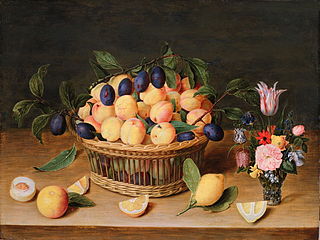
Jacob van Hulsdonck or Jan van Hulsdonck, was a Flemish painter who played a role in the early development of the genre of still lifes of fruit, banquets and flowers.

Jean Adolphe Braun was a French photographer, best known for his floral still lifes, Parisian street scenes, and grand Alpine landscapes.

Peter Wickens Fry was a pioneering English amateur photographer, although professionally he was a London solicitor. In the early 1850s, Fry worked with Frederick Scott Archer, assisting him in the early experiments of the wet collodion process. He was also active in helping Roger Fenton to set up the Royal Photographic Society in 1853. Several of his photographs are in the Victoria and Albert Museum in London.

Deborah Griscom Passmore (1840–1911) was a botanical illustrator for the U.S. Department of Agriculture who specialized in paintings of fruit. Her work is now preserved in the USDA's Pomological Watercolor Collection, and she has been called the best of the early USDA artists. She rose to lead the USDA staff artists, and she became the most prolific of the group, contributing one-fifth of the 7500 paintings in the Pomological Watercolor Collection.

Robert Jefferson Bingham was an English pioneer photographer, mainly active in France, making portraits and reproductions of paintings. He is one of the first photographers to use and write about the collodion process, which he claimed to have invented.

Reverend Thomas Frederick Hardwich was a photographic chemist, writer on photographic chemistry, demonstrator and lecturer in photography at King's College London, and the author of A Manual of Photographic Chemistry including the practice of the Collodion Process, then later, curate of St John, Shildon, in the diocese of Durham.
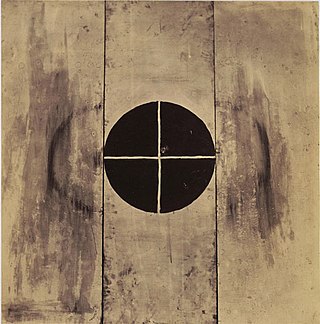
The Queen's Target is a black and white photograph by the English photographer Roger Fenton, made in 1860. The picture was taken at the first Imperial Meeting, organised by the British National Rifle Association on Wimbledon Common in 1860, and it shows the target where Queen Victoria hit the bull's eye with her rifle.



















